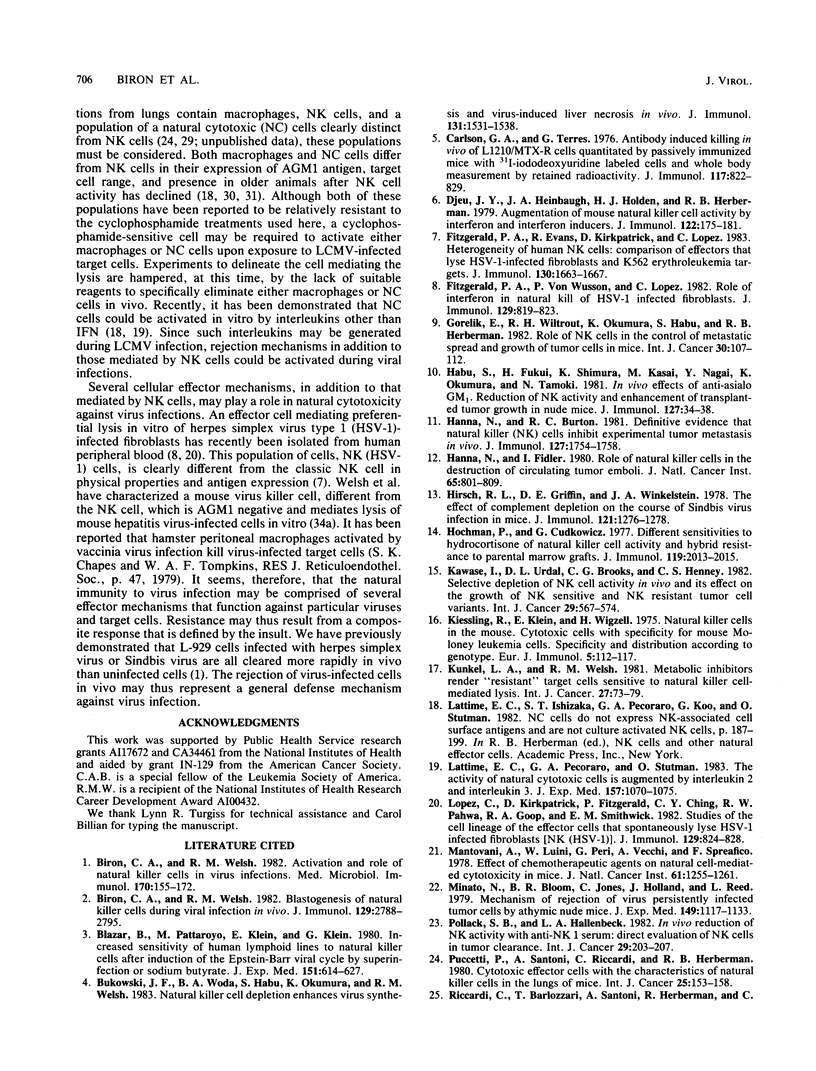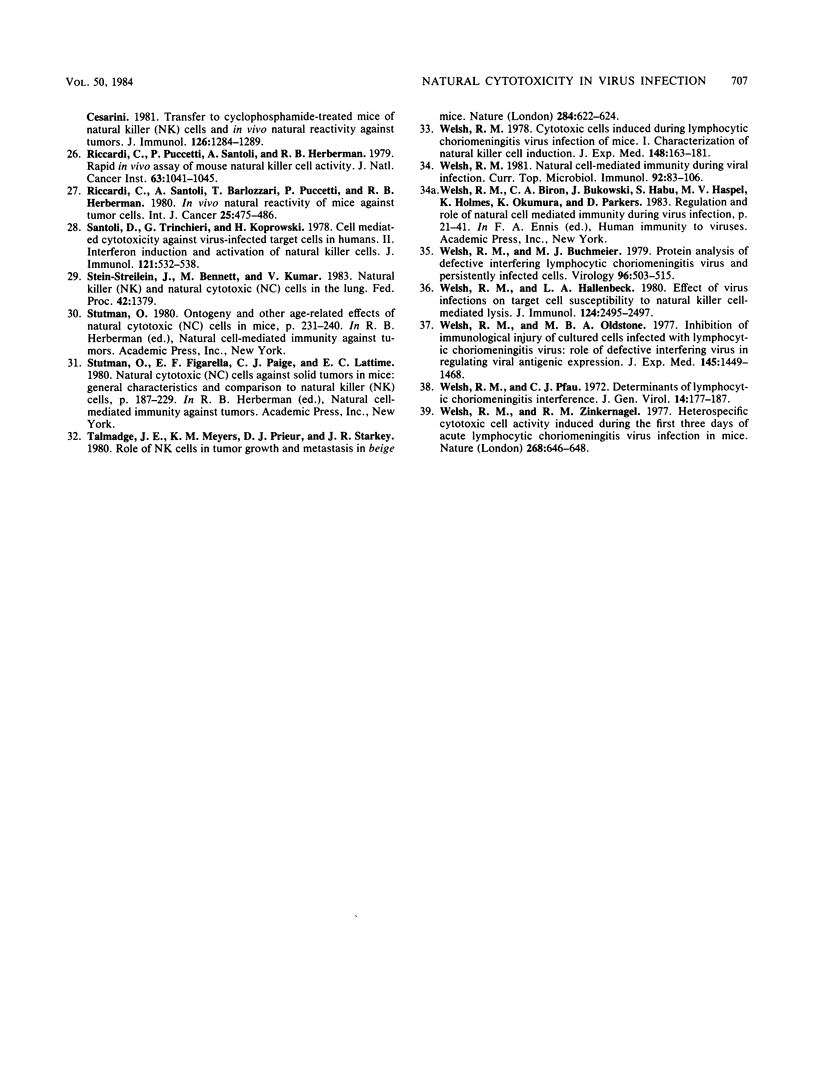Abstract
To examine the lysis of virus-infected cells in vivo, uninfected and lymphocytic choriomeningitis virus (LCMV)-infected L-929 cells were labeled in vitro with [125I]-iododeoxyuridine and implanted intravenously into mice. Natural cytotoxicity against both uninfected and virus-infected cells was demonstrated in normal uninfected mice, but LCMV-infected cells were cleared from the lungs and whole bodies more rapidly than uninfected cells. Treatment of L-929 cells with defective interfering LCMV inhibited standard virus synthesis and protected the target cells from enhanced in vivo rejection. The in vivo rejection was apparently mediated by a cellular constituent of the host immune response and not simply a result of virus-induced cytopathic effects on the target cell, as hydrocortisone acetate and cyclophosphamide each reduced rejection of both target cell types and eliminated the enhanced rejection of LCMV-infected cells. The enhanced rejection of LCMV-infected cells was not restricted by histocompatibility antigens, indicating that classic T-cell recognition was not involved in the lysis, and since the enhanced rejection of LCMV-infected cells was mediated by mice treated with cobra venom factor, complement was also not involved in the lysis. Although moderate levels of interferon (102 U/ml) were present in the sera and although there was a modest activation of natural killer (NK) cells in the lungs of LCMV-infected cell recipients but not uninfected cell recipients, the enhanced rejection of virus-infected cells did not appear to be NK cell mediated. Normal mice and mice depleted of NK cell activity by in vivo treatment with antibody to asialo ganglio-n-tetraosylceramide ( AGM1 ) rejected uninfected and LCMV-infected L-929 cells similarly. This antibody markedly inhibited the rejection of NK-sensitive YAC-1 cells. In addition to the natural cytotoxicity directed against virus-infected cells, a second nonspecific rejection mechanism appeared in response to treatment protocols which induced interferon. Polyinosinic-polycytidylic acid and infection with LCMV augmented in vivo rejection of both uninfected and LCMV-infected L-929 cells but eliminated the differential rejection of the virus-infected cells. Infection with LCMV also augmented the in vivo rejection of the NK-sensitive target cell, YAC-1. In vivo treatments with anti- AGM1 sera only moderately inhibited the elevated rejection of uninfected and LCMV-infected L-929 cells, indicating that the enhanced rejection of these target cells was predominantly mediated by a mechanism other than that mediated by NK cells.(ABSTRACT TRUNCATED AT 400 WORDS)
Full text
PDF









Selected References
These references are in PubMed. This may not be the complete list of references from this article.
- Biron C. A., Welsh R. M. Activation and role of natural killer cells in virus infections. Med Microbiol Immunol. 1982;170(3):155–172. doi: 10.1007/BF02298196. [DOI] [PubMed] [Google Scholar]
- Biron C. A., Welsh R. M. Blastogenesis of natural killer cells during viral infection in vivo. J Immunol. 1982 Dec;129(6):2788–2795. [PubMed] [Google Scholar]
- Blazar B., Patarroyo M., Klein E., Klein G. Increased sensitivity of human lymphoid lines to natural killer cells after induction of the Epstein-Barr viral cycle by superinfection or sodium butyrate. J Exp Med. 1980 Mar 1;151(3):614–627. doi: 10.1084/jem.151.3.614. [DOI] [PMC free article] [PubMed] [Google Scholar]
- Bukowski J. F., Woda B. A., Habu S., Okumura K., Welsh R. M. Natural killer cell depletion enhances virus synthesis and virus-induced hepatitis in vivo. J Immunol. 1983 Sep;131(3):1531–1538. [PubMed] [Google Scholar]
- Carlson G. A., Terres G. Antibody-induced killing in vivo of L1210/MTX-R cells quantitated in passively immunized mice with 131I-iododeoxyuridine-labeled cells and whole-body measurement of retained radioactivity. J Immunol. 1976 Sep;117(3):822–829. [PubMed] [Google Scholar]
- Djeu J. Y., Heinbaugh J. A., Holden H. T., Herberman R. B. Augmentation of mouse natural killer cell activity by interferon and interferon inducers. J Immunol. 1979 Jan;122(1):175–181. [PubMed] [Google Scholar]
- Fitzgerald P. A., Evans R., Kirkpatrick D., Lopez C. Heterogeneity of human NK cells: comparison of effectors that lyse HSV-1-infected fibroblasts and K562 erythroleukemia targets. J Immunol. 1983 Apr;130(4):1663–1667. [PubMed] [Google Scholar]
- Fitzgerald P. A., von Wussow P., Lopez C. Role of interferon in natural kill of HSV-1-infected fibroblasts. J Immunol. 1982 Aug;129(2):819–823. [PubMed] [Google Scholar]
- Gorelik E., Wiltrout R. H., Okumura K., Habu S., Herberman R. B. Role of NK cells in the control of metastatic spread and growth of tumor cells in mice. Int J Cancer. 1982 Jul 15;30(1):107–112. doi: 10.1002/ijc.2910300118. [DOI] [PubMed] [Google Scholar]
- Habu S., Fukui H., Shimamura K., Kasai M., Nagai Y., Okumura K., Tamaoki N. In vivo effects of anti-asialo GM1. I. Reduction of NK activity and enhancement of transplanted tumor growth in nude mice. J Immunol. 1981 Jul;127(1):34–38. [PubMed] [Google Scholar]
- Hanna N., Burton R. C. Definitive evidence that natural killer (NK) cells inhibit experimental tumor metastases in vivo. J Immunol. 1981 Nov;127(5):1754–1758. [PubMed] [Google Scholar]
- Hanna N., Fidler I. J. Role of natural killer cells in the destruction of circulating tumor emboli. J Natl Cancer Inst. 1980 Oct;65(4):801–809. doi: 10.1093/jnci/65.4.801. [DOI] [PubMed] [Google Scholar]
- Hirsch R. L., Griffin D. E., Winkelstein J. A. The effect of complement depletion on the course of Sindbis virus infection in mice. J Immunol. 1978 Oct;121(4):1276–1278. [PubMed] [Google Scholar]
- Hochman P. S., Cudkowicz G. Different sensitivities to hydrocortisone of natural killer cell activity and hybrid resistance to parental marrow grafts. J Immunol. 1977 Dec;119(6):2013–2015. [PubMed] [Google Scholar]
- Kawase I., Urdal D. L., Brooks C. G., Henney C. S. Selective depletion of NK cell activity in vivo and its effect on the growth of NK-sensitive and NK-resistant tumor cell variants. Int J Cancer. 1982 May 15;29(5):567–574. doi: 10.1002/ijc.2910290513. [DOI] [PubMed] [Google Scholar]
- Kiessling R., Klein E., Wigzell H. "Natural" killer cells in the mouse. I. Cytotoxic cells with specificity for mouse Moloney leukemia cells. Specificity and distribution according to genotype. Eur J Immunol. 1975 Feb;5(2):112–117. doi: 10.1002/eji.1830050208. [DOI] [PubMed] [Google Scholar]
- Kunkel L. A., Welsh R. M. Metabolic inhibitors render "resistant" target cells sensitive to natural killer cell-mediated lysis. Int J Cancer. 1981 Jan 15;27(1):73–79. doi: 10.1002/ijc.2910270112. [DOI] [PubMed] [Google Scholar]
- Lattime E. C., Pecoraro G. A., Stutman O. The activity of natural cytotoxic cells is augmented by interleukin 2 and interleukin 3. J Exp Med. 1983 Mar 1;157(3):1070–1075. doi: 10.1084/jem.157.3.1070. [DOI] [PMC free article] [PubMed] [Google Scholar]
- Lopez C., Kirkpatrick D., Fitzgerald P. A., Ching C. Y., Pahwa R. N., Good R. A., Smithwick E. M. Studies of the cell lineage of the effector cells that spontaneously lyse HSV-1 infected fibroblasts (NK(HSV-1)). J Immunol. 1982 Aug;129(2):824–828. [PubMed] [Google Scholar]
- Mantovani A., Luini W., Peri G., Vecchi A., Spreafico F. Effect of chemotherapeutic agents on natural cell-mediated cytotoxicity in mice. J Natl Cancer Inst. 1978 Nov;61(5):1255–1261. doi: 10.1093/jnci/61.5.1255. [DOI] [PubMed] [Google Scholar]
- Minato N., Bloom B. R., Jones C., Holland J., Reid L. M. Mechanism of rejection of virus persistently infected tumor cells by athymic nude mice. J Exp Med. 1979 May 1;149(5):1117–1133. doi: 10.1084/jem.149.5.1117. [DOI] [PMC free article] [PubMed] [Google Scholar]
- Pollack S. B., Hallenbeck L. A. In vivo reduction of NK activity with anti-NK 1 serum: direct evaluation of NK cells in tumor clearance. Int J Cancer. 1982 Feb 15;29(2):203–207. doi: 10.1002/ijc.2910290215. [DOI] [PubMed] [Google Scholar]
- Puccetti P., Santoni A., Riccardi C., Herberman R. B. Cytotoxic effector cells with the characteristics of natural killer cells in the lungs of mice. Int J Cancer. 1980 Jan 15;25(1):153–158. doi: 10.1002/ijc.2910250121. [DOI] [PubMed] [Google Scholar]
- Riccardi C., Barlozzari T., Santoni A., Herberman R. B., Cesarini C. Transfer to cyclophosphamide-treated mice of natural killer (NK) cells and in vivo natural reactivity against tumors. J Immunol. 1981 Apr;126(4):1284–1289. [PubMed] [Google Scholar]
- Riccardi C., Puccetti P., Santoni A., Herberman R. B. Rapid in vivo assay of mouse natural killer cell activity. J Natl Cancer Inst. 1979 Oct;63(4):1041–1045. [PubMed] [Google Scholar]
- Riccardi C., Santoni A., Barlozzari T., Puccetti P., Herberman R. B. In vivo natural reactivity of mice against tumor cells. Int J Cancer. 1980 Apr 15;25(4):475–486. doi: 10.1002/ijc.2910250409. [DOI] [PubMed] [Google Scholar]
- Santoli D., Trinchieri G., Koprowski H. Cell-mediated cytotoxicity against virus-infected target cells in humans. II. Interferon induction and activation of natural killer cells. J Immunol. 1978 Aug;121(2):532–538. [PubMed] [Google Scholar]
- Talmadge J. E., Meyers K. M., Prieur D. J., Starkey J. R. Role of NK cells in tumour growth and metastasis in beige mice. Nature. 1980 Apr 17;284(5757):622–624. doi: 10.1038/284622a0. [DOI] [PubMed] [Google Scholar]
- Welsh R. M., Jr, Buchmeier M. J. Protein analysis of defective interfering lymphocytic choriomeningitis virus and persistently infected cells. Virology. 1979 Jul 30;96(2):503–515. doi: 10.1016/0042-6822(79)90107-7. [DOI] [PubMed] [Google Scholar]
- Welsh R. M., Jr Cytotoxic cells induced during lymphocytic choriomeningitis virus infection of mice. I. Characterization of natural killer cell induction. J Exp Med. 1978 Jul 1;148(1):163–181. doi: 10.1084/jem.148.1.163. [DOI] [PMC free article] [PubMed] [Google Scholar]
- Welsh R. M., Jr, Hallenbeck L. A. Effect of virus infections on target cell susceptibility to natural killer cell-mediated lysis. J Immunol. 1980 May;124(5):2491–2497. [PubMed] [Google Scholar]
- Welsh R. M., Jr, Zinkernagel R. M. Heterospecific cytotoxic cell activity induced during the first three days of acute lymphocytic choriomeningitis virus infection in mice. Nature. 1977 Aug 18;268(5621):646–648. doi: 10.1038/268646a0. [DOI] [PubMed] [Google Scholar]
- Welsh R. M. Natural cell-mediated immunity during viral infections. Curr Top Microbiol Immunol. 1981;92:83–106. doi: 10.1007/978-3-642-68069-4_6. [DOI] [PubMed] [Google Scholar]
- Welsh R. M., Oldstone M. B. Inhibition of immunologic injury of cultured cells infected with lymphocytic choriomeningitis virus: role of defective interfering virus in regulating viral antigenic expression. J Exp Med. 1977 Jun 1;145(6):1449–1468. doi: 10.1084/jem.145.6.1449. [DOI] [PMC free article] [PubMed] [Google Scholar]
- Welsh R. M., Pfau C. J. Determinants of lymphocytic choriomeningitis interference. J Gen Virol. 1972 Feb;14(2):177–187. doi: 10.1099/0022-1317-14-2-177. [DOI] [PubMed] [Google Scholar]


